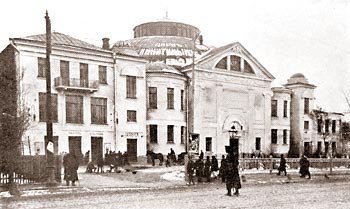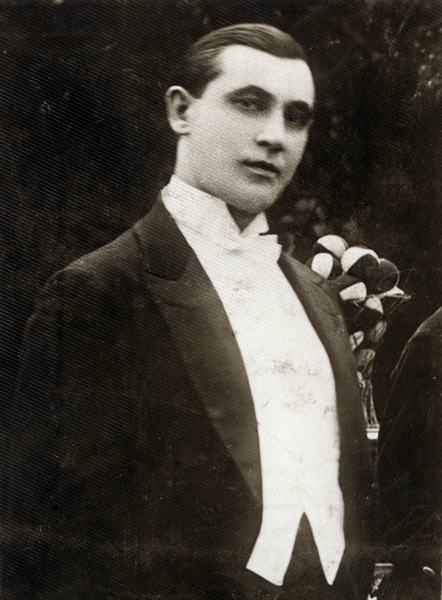Театр Варьете
Русский > Места > Места из романа > Театр Варьете
Мы продолжаем напряженно работать, чтобы улучшить наш сайт и перевести его на другие языки. Русская версия этой страницы еще не совсем готова. Поэтому мы представляем здесь пока английскую версию. Мы благодарим вас за понимание.
Context
In the Variety Theatre, Woland and his retinue organize a performance of black magic in which the master of ceremony George Bengalsky is decapitated, in which the ladies from the public can scramble to their hearts’ content in an abundance of luxury clothes and jewels which leads to chaotic and hilarious scenes. A performance also in which chervontsi or ten-rouble bills flutter all over the spectators, and in which the guest of honour of that night, Arkady Appolonovich Sempleyarov, the self-satisfied chairman of the Acoustics Commission of the Moscow theatres, is revealed for being a debauchee, in presence of his wife and his cute niece. In short: «something like Babel broke loose in the Variety».
Prototype
The Театр Варьете or Variety Theatre from the novel did not really exist, it is a fictional building modeled on the Государственный Московский мюзик-холл [Gosoedarstvenni Moskovski muzhik-holl] or the Moscow State Music Hall from the 1920s. The Music Hall was located at the beginning of the Bolshaya Sadovaya at the Triumphalnaya Square, at the place where the Московский академический театр Сатиры [Moskovski akademitsjeski teatr Satiri] or the Moscow Academic Satire Theatre is now located.
The building, which was close to the apartment where Woland and his suite would move in, was conceived in 1911 as a circular circus by architect Bogdan Mikhailovich Nilus (1866-1919). He had designed it as the first Russian circus of the brothers Nikitin, Dmitri (1835-1918), Akim (1843-1917), and Pyotr (1846-1921), who started to compete with the existing circus on Tsvetnoy Boulevard. Bulgakov was able to visit the Nikitin circus before it closed its doors in the early 1920s, and described it in his novels The Fatal Eggs and A Dog's Heart, and in the theatre play The Flight. In 1926, the circus was converted into a theatre and was renamed the Second State Circus - Music Hall, and later the Moscow Music Hall. It had 1766 seats and several balconies.
In the first versions of The Master and Margarita, the Variety Theatre had a different name: it was then called Театр Кабаре [Teatr Kabare] or Cabaret Theatre.
Bulgakov has taken the name Variety Theatre from the Théâtre des variétés in Paris, a theatre known for its vaudeville. It was founded in 1789 at the Palais Royal by Marguerite Brunet (1730-1820), nicknamed Mademoiselle Montance. When it was closed by an imperial decree in 1807, the whole company moved to the Boulevard Montmartre no. 7, where it is still located.
Artists
In the guide Theatres of Moscow, published in 1930, the Moscow Music Hall is described as a place where, in addition to the permanent company, many Soviet and foreign artists performed. In the vaudeville theatre which was shown in the Music Hall at that time, several - often comic - acts were played one after the other and presented as one big show. They were linked to each other by conferenciers such as Georgy (George) Razdolsky and Alexander Alexandrovich Grill, who both gave inspiration to the character of George Bengalsky in The Master and Margarita.
The list of artists who performed in the Music Hall will probably ring a bell with the readers of The Master and Margarita.
The first one in the row was Nikolay Alexandrovich Smirnov (1880-1958), who performed as Orlando, an illusionist and hypnotist who would have had devilish powers. According to a stubborn legend, he would have been arrested in the mid-1930s, but he would have hypnotized the researchers and the guards to go home unhindered. Others claim that he cooperated with the NKVD. This story is based on the fact that Smirnov's daughter Antonina Nikolaevna (1921-1974) was married to Viktor Semyonovich Abakumov (1908-1954), an employee of the NKVD who, in 1946, would become the head of State Security.
In 1928, in the period that Bulgakov began to write the first version of The Master and Margarita, Harry August Jansen (1883-1955) was on tour in Moscow. He was an American artist of Danish origin, who performed as Dante the Magician. Through his make-up he looked like Mephistopheles, the devil that appears in the Faust of Johann Wolfgang von Goethe (1749-1832). One of the places where he performed was the Music Hall in Moscow. According to the audience, he looked at them «with the condescending smile of a devil-philosopher».
In 1940, Jansen published Sim-Sala-Bim, 50 Tricks For Everybody, a programme brochure of 28 pages, in which he «exposed» several of his tricks himself.
A well known company in the Music Hall in the 30’s was the Труппа Польди [Truppa Poldi] or the Poldi company, which was the artist name for the Podrezov family which showed its bicycle tricks and which was called the Giulli family by Bulgakov at the beginning of chapter 12. On posters from that time the man in the yellow bowler-hat and the blond woman on a single wheel can be recognized. Bulgakov writes that the woman is wearing a трико [triko], the Russian transliteration of tricot or jersey - the first of many French words he will use in that chapter.
Another artist who regularly performed at the Music Hall was the Greek illusionist Kostantin Mikhailovich Kasfikis (1892-1934). He performed under the stage name Kostano. One of his acts was the Money Factory, a kind of device in which he put white sheets of paper which, after a few manipulations, came out of it as «real money».
Metro: Маяковская (Mayakovskaya)
Поместить эту страницу |



